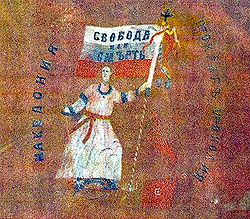Ilinden–Preobrazhenie Uprising
The Ilinden–Preobrazhenie Uprising was an uprising by mostly Bulgarian[1][2] and some of the Aromanian population in certain regions in the Ottoman Empire.[3] The uprising was against Ottoman rule.[4]
The uprising lasted from 2 August 1903 up to November 1903.
The name of the uprising comes from the Christian Orthodox holy day of Ilinden as well as another holy day known as Preobrazhenie on which the revolts began.
Ultimately the uprising was crushed by the better equipped and much larger Ottoman army. The casualties were on both sides were small however a large number of people were made homeless, the majority of which number around 30,000 fled to Bulgaria.[5]
Ilinden–Preobrazhenie Uprising Media
Vojvods in Odrin Vilayet before the uprising.
Hristo Chernopeev's band in 1903.
The banner of the insurgents from Ohrid with Bulgarian flag on it and the inscription Свобода или смърть, "Freedom or Death." The insurgents flew Bulgarian flags everywhere.
The flag of the Struga insurgent detachment. It has also Bulgarian flag on it, and the Bulgarian motto Свобода или смърть.
Celebration of the Ilinden Uprising in Bitola during WWI Bulgarian occupation of Southern Serbia.
References
- ↑ "However, contrary to the impression of researchers who believe that the Internal organization espoused a "Macedonian national consciousness," the local revolutionaries declared their conviction that the "majority" of the Christian population of Macedonia is "Bulgarian." They clearly rejected possible allegations of what they call "national separatism" vis-a-vis the Bulgarians, and even consider it "immoral." Though they declared an equal attitude towards all the "Macedonian populations." Tschavdar Marinov, We the Macedonians, The Paths of Macedonian Supra-Nationalism (1878–1912), in "We, the People: Politics of National Peculiarity in Southeastern Europe" with Mishkova Diana as ed., Central European University Press, 2009, ISBN 9639776289, pp. 107-137.
- ↑ The political and military leaders of the Slavs of Macedonia at the turn of the century seem not to have heard the call for a separate Macedonian national identity; they continued to identify themselves in a national sense as Bulgarians rather than Macedonians.[...] (They) never seem to have doubted "the predominantly Bulgarian character of the population of Macedonia". "The Macedonian conflict: ethnic nationalism in a transnational world", Princeton University Press, Danforth, Loring M. 1997, ISBN 0691043566, p. 64.
- ↑ Autonomy for Macedonia and the vilayet of Adrianople (southern Thrace) became the key demand for a generation of Slavic activists. In October 1893, a group of them founded the Bulgarian Macedono-Adrianopolitan Revolutionary Committee in Salonica...It engaged in creating a network of secretive committees and armed guerrillas in the two regions as well as in Bulgaria, where an ever-growing and politically influential Macedonian and Thracian diaspora resided. Heavily influenced by the ideas of early socialism and anarchism, the IMARO activists saw the future autonomous Macedonia as a multinational polity, and did not pursue the self-determination of Macedonian Slavs as a separate ethnicity. Therefore, Macedonian (and also Adrianopolitan) was an umbrella term covering Bulgarians, Turks, Greeks, Vlachs, Albanians, Serbs, Jews, and so on. While this message was taken aboard by many Vlachs as well as some Patriarchist Slavs, it failed to impress other groups for whom the IMARO remained the Bulgarian Committee.' Historical Dictionary of Republic of Macedonia, Historical Dictionaries of Europe, Dimitar Bechev, Scarecrow Press, 2009, ISBN 0810862956, Introduction.
- ↑ Chisholm, Hugh (1910–1922). The Encyclopaedia Britannica : a dictionary of arts, sciences, literature and general information. Internet Archive. New York : Encyclopaedia Britannica.
- ↑ Македония и Одринско 1893–1903. Мемоар на Вътрешната организация. [Macedonia and Adrianople Region 1893–1903. A Memoir of the Internal Organization.] (in Bulgarian). Sofia: Internal Macedonian-Adrianople Revolutionary Organization. 1904.








